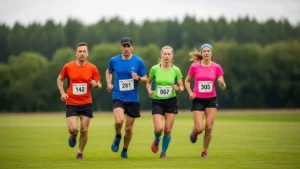
Introduction: Quick Answers to Common Queries
How many miles is a 10K run?
A 10K run equals 6.2 miles. The exact conversion is 6.2137 miles, but most runners round it to 6.2 for simplicity. This makes a 10K race a middle-distance event, longer than a 5K (3.1 miles) but much shorter than a half marathon (13.1 miles).
When you hear “10K,” it’s shorthand for ten kilometers. Since most countries use kilometers in racing, knowing the mile equivalent helps runners in the U.S. or U.K. compare training distances. Think of it as running around a standard 400-meter track about 25 times.
How long does it take to run a 10K?
The average runner finishes a 10K in 50 to 70 minutes. Elite runners complete it in under 30 minutes, while beginners may take 70 to 90 minutes depending on pace and fitness levels. Time depends on your pace per mile. For example, running 10 minutes per mile means you’ll finish in just over an hour. Training plans often use mile pacing because it’s easier to track splits and predict finish times.
Why do races use kilometers instead of miles?
Races use kilometers because it’s the international standard for track and road events. Governing bodies like World Athletics set distances in meters and kilometers, which is why races are labeled as 5K, 10K, or marathon (42.195K). In countries like the U.S., people often convert to miles for training or casual conversation. But globally, kilometers keep everything consistent. Whether you’re racing in Tokyo, London, or Boston, the 10K always measures the same distance.
Understanding the Basics of a 10K
What does 10K stand for in running?
In running, 10K means ten kilometers, which equals 10,000 meters. It’s one of the most popular race distances worldwide, bridging the gap between short races like 5K and endurance races like marathons. The “K” stands for kilometer, a unit used in most road and track events. While miles are common in the U.S. and U.K., the 10K has become a universal distance in the running community, making it easy for athletes across countries to compare performance.
The official 10K distance in miles
The official 10K distance is 6.2137 miles. Most people round this number down to 6.2 miles for training and race-day conversations. This distance is certified by governing bodies such as World Athletics. Whether you’re running a city road race or an Olympic-level event, the 10K remains the same. Using miles helps runners track splits more clearly, especially in regions where training routes are marked in miles.
How 10K compares to 5K and a half marathon
A 10K is twice the distance of a 5K (3.1 miles) and less than half the distance of a half marathon (13.1 miles). It’s often seen as a stepping stone between shorter and longer races. Many beginners start with a 5K before moving to a 10K. For those eyeing a half marathon, the 10K is a perfect test of endurance and pacing. It challenges stamina without the heavy training load that comes with half or full marathons.
Converting 10K to Miles: The Simple Formula
The kilometer-to-mile conversion rate
One kilometer equals 0.62137 miles. This fixed conversion rate is used worldwide when changing between kilometers and miles. It doesn’t change by context—whether you’re running, driving, or calculating distances for training. Runners often memorize this rate to switch between units quickly. For example, 5 kilometers equals about 3.1 miles, making it a useful number for everyday training.
Step-by-step conversion for 10K
To convert 10K to miles, multiply 10 kilometers by 0.62137. The answer is 6.2137 miles.
Here’s the breakdown:
- Formula: kilometers × 0.62137 = miles
- Calculation: 10 × 0.62137 = 6.2137 miles
This step-by-step method works for any distance. If you’re training for 15K or 20K, just multiply the kilometers by the same conversion rate, and you’ll have your mile distance right away.
10K in miles rounded for simplicity
Most runners round 10K to 6.2 miles. This makes it easier to track mileage and pacing without focusing on decimals. Race organizers and coaches usually use 6.2 miles in training plans. While the exact figure is 6.2137 miles, the rounded version keeps calculations simple and doesn’t affect performance tracking in any practical way.
How 10K in Miles Fits into Training
Average finish times for 10K in miles
The average 10K finish time is about 50 to 70 minutes, which equals running 6.2 miles at an 8–11 minute per mile pace. Elite athletes cover it in under 30 minutes, while beginners may take 70 to 90 minutes. These times vary by fitness level, age, and gender. Recreational runners often train with a 9–10 minute per mile pace, finishing around an hour. Using miles makes pacing easier since most U.S. running routes and treadmill settings are in miles.
Training tips based on mile pacing
Training for 10K works best when you set your pace per mile. Breaking the 6.2 miles into mile splits helps track progress and predict finish times. For example, if you run each mile in 9 minutes, you’ll finish in about 56 minutes. Long runs should be slower, while interval training should push your pace faster than goal race speed. Tracking miles gives a clearer picture of endurance and stamina gains.
Common mistakes runners make when switching units
The biggest mistake is confusing pace per kilometer with pace per mile. Since a mile is longer than a kilometer, mixing the two can throw off training speed and race goals. Another mistake is ignoring decimal points. Rounding 10K to 6 miles instead of 6.2 may not seem like much, but over multiple runs it adds up. Consistency is key, so use accurate conversions and stick with either miles or kilometers for each training cycle.
Why Runners Should Know Both Miles and Kilometers
International race measurements
Most races worldwide use kilometers because governing bodies like World Athletics set distances in metric units. A 10K is always 10 kilometers, no matter where the event takes place. If you race abroad, you’ll see signs in kilometers. U.S. runners often need to convert these distances into miles to understand pacing. Knowing both units ensures you won’t misjudge your speed or miscalculate remaining distance in a race.
Apps and fitness trackers showing mixed units
Fitness trackers often default to kilometers, even in countries that use miles. Some apps let you switch units, while others display both at once. This can confuse runners who track progress in one system but race in another. For example, Strava shows kilometers by default, while Garmin lets you choose. Understanding both units makes the data more meaningful, whether you’re training at home or abroad.
Setting goals using both systems
Setting goals in both miles and kilometers makes you more adaptable. A 6.2-mile race is the same as a 10K, but thinking in both ways helps with training and race preparation. For instance, planning intervals of 1 kilometer can build speed, while mile repeats can build endurance. Switching between units gives runners flexibility in training plans and avoids confusion when crossing from local runs to international events.
Useful Data and Stats for 10K Runners
World record times for 10K (men and women)
The men’s 10K world record is 26:11 set by Rhonex Kipruto in 2020, and the women’s record is 29:14 set by Yalemzerf Yehualaw in 2022. These records show the fastest times ever run for the 6.2-mile distance. These performances highlight what’s possible at the elite level. While most recreational runners won’t approach these times, they serve as benchmarks for understanding the difference between professional and everyday racing. Watching these athletes often inspires new runners to push their limits.
Average 10K times by age group
The average 10K finish time is about 50 to 70 minutes overall, but times vary by age. Runners in their 20s and 30s often average 48–55 minutes, while those over 50 may average closer to 60–75 minutes. Race surveys show that younger runners generally run faster, but training consistency matters more than age. For example, a well-trained 50-year-old can outperform a casual 25-year-old. Understanding averages helps runners set realistic pacing goals for their own 6.2-mile races.
Calorie burn estimates for 10K in miles
Running 6.2 miles burns about 600 to 900 calories, depending on body weight, speed, and efficiency. Heavier runners burn more, while lighter runners burn less. For example, a 150-pound runner may burn around 700 calories at a moderate pace. Running faster raises calorie use, while walking the same distance burns fewer calories. Many runners use this stat to track weight-loss goals or balance nutrition during training.
Practical Tools for 10K to Miles Conversion
Conversion chart for quick reference
A simple conversion chart is one of the most practical tools for runners who frequently need to switch between kilometers and miles. Since 10K equals approximately 6.2 miles, charts can help break down smaller increments such as 1K to 0.62 miles or 5K to 3.1 miles. Keeping this chart handy allows runners to quickly understand distances during training or when following international race plans without pausing to calculate.
Online calculators and mobile apps
Many websites and running apps offer instant conversion calculators where you can enter a distance in kilometers and get the equivalent in miles, or vice versa. Apps like Strava, Garmin Connect, and Runkeeper already provide mixed unit tracking, which makes it easy to visualize progress. Online calculators are especially helpful when mapping out personalized training schedules or adapting workouts from sources that use different measurement systems.
Printable conversion tables for training logs
For runners who prefer physical training journals or logs, printable conversion tables are a valuable tool. These tables can be inserted into a running notebook or pinned to a home workout space, allowing quick reference without needing to open a phone or computer. A table showing 1K to 20K alongside their mile equivalents helps athletes track mileage consistently and adjust their runs without confusion.
Conclusion
Converting a 10K race into miles doesn’t have to be complicated. With the simple fact that 10K equals about 6.2 miles, runners can confidently train, track progress, and set realistic goals across different systems of measurement. Whether using a quick reference chart, an online calculator, or a fitness app, understanding this conversion ensures smoother training and race preparation. Knowing both miles and kilometers also helps runners adapt to international races and fitness tools that often mix units.
FAQs
Is running 10K hard for beginners?
For beginners, running 10K (6.2 miles) can feel challenging, but it’s an achievable goal with proper training. Most new runners can prepare for a 10K in 8–10 weeks by gradually increasing distance and combining running with rest days. With consistency, the distance becomes manageable and rewarding.
How many steps equal a 10K run?
On average, a 10K run equals about 12,000–15,000 steps, depending on stride length, height, and pace. Faster runners with longer strides may take fewer steps, while shorter strides require more. Using a fitness tracker can help get a more personalized step count.
Can walking 10K give the same benefits?
Yes, walking 10K (around 6.2 miles) still offers excellent health benefits, though it differs from running. Walking burns fewer calories and takes more time, but it improves cardiovascular health, strengthens muscles, and supports endurance. For those unable to run, it’s a low-impact alternative with meaningful fitness gains.
What’s a good 10K pace in miles?
A good pace depends on fitness level. Beginners often run around 10–12 minutes per mile, while intermediate runners average 8–9 minutes per mile. Competitive athletes may aim for 6–7 minutes per mile or faster. Tracking pace in miles helps runners set realistic race and training goals.
How to switch between kilometers and miles during training?
Switching between kilometers and miles is simple with apps, GPS watches, or conversion formulas. Many devices allow you to toggle between units. Remember that 1 kilometer = 0.62 miles and 1 mile = 1.61 kilometers. Practicing in both units helps runners adapt to international races and different training programs.







